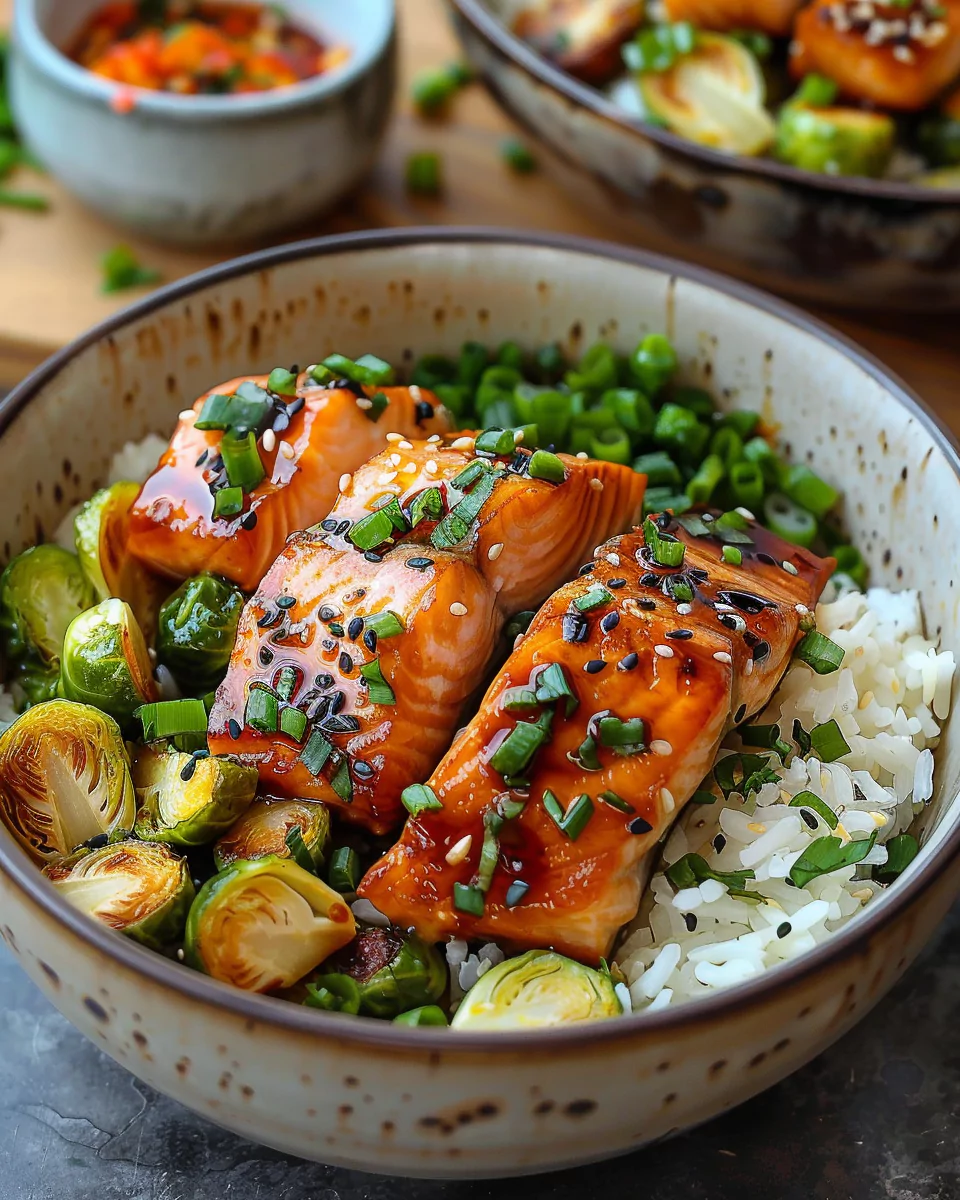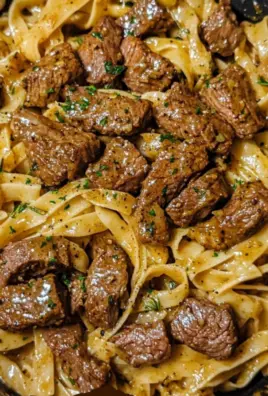What Are Teriyaki Salmon Bowls?
Introduce the concept of teriyaki salmon bowls. Discuss their origins and how they combine the rich, savory flavor of teriyaki sauce with the health benefits and deliciousness of salmon. Highlight how the dish is typically served as a balanced meal in a bowl, combining proteins, vegetables, and grains or other bases.

The Popularity of Bowl Meals in Modern Cuisine
Explain why bowl meals have become a culinary trend, emphasizing their convenience, versatility, and ability to cater to various dietary preferences. Provide examples of similar bowl meals to contextualize the appeal of teriyaki salmon bowls.
Health Benefits of Salmon and Brussels Sprouts
Detail the nutritional value of salmon, focusing on its omega-3 fatty acids, high-quality protein, and essential vitamins. Then, discuss Brussels sprouts as a nutrient-rich vegetable packed with vitamins, fiber, and antioxidants. Conclude by highlighting how this dish is a great choice for a wholesome, health-conscious meal.
Part 2: Ingredients and Preparation
Selecting Fresh Salmon
Discuss the importance of choosing high-quality salmon for this recipe. Highlight the differences between wild-caught and farm-raised salmon, focusing on flavor, nutritional value, and environmental considerations. Provide tips on identifying fresh salmon, such as checking for bright, shiny skin, firm texture, and a mild ocean smell.
- Wild-Caught vs. Farm-Raised Salmon
Explain the advantages of wild-caught salmon in terms of sustainability and flavor profile. Contrast it with farm-raised options, which might be more affordable and accessible but may differ in taste and nutritional content. - Signs of Freshness to Look For
Offer specific tips for selecting the freshest salmon, such as avoiding fillets with discoloration or fishy odors.
Choosing the Perfect Brussels Sprouts
Guide readers on selecting Brussels sprouts that will result in a crispy, flavorful dish. Highlight how size and color affect taste and cooking texture. Smaller sprouts often have a sweeter flavor, while larger ones can be more robust but may require additional trimming.
- Size and Color Indicators
Recommend opting for smaller, tightly packed sprouts with vibrant green leaves. - Seasonality and Availability
Discuss how seasonal produce typically offers the best flavor and quality, and suggest suitable alternatives when Brussels sprouts are out of season.
Essential Components of Teriyaki Sauce
Dive into what makes a great teriyaki sauce. Highlight traditional ingredients such as soy sauce, mirin, sugar, and ginger, and discuss the balance of sweet and savory flavors. Offer a basic homemade teriyaki sauce recipe and compare it to store-bought options for those short on time.
- Traditional Ingredients
Describe the role of each ingredient in creating the distinct taste of teriyaki sauce. - Homemade vs. Store-Bought Options
Weigh the pros and cons of making the sauce from scratch versus using a pre-made version. Suggest high-quality store-bought brands for convenience.
Part 3: Step-by-Step Cooking Instructions
Marinating the Salmon
Explain the importance of marinating salmon to infuse it with rich teriyaki flavor. Provide a step-by-step guide on preparing the marinade and soaking the salmon. Include tips for achieving even coating and how long to marinate for optimal taste.
- Duration and Techniques for Optimal Flavor
Recommend marinating for 20–30 minutes for quick preparation or up to 2 hours for deeper flavor. Offer advice on using a resealable bag or shallow dish for efficient marinating.
Achieving Crispy Brussels Sprouts
Guide readers on how to roast Brussels sprouts to achieve maximum crispiness. Include preparation steps, such as trimming, halving, and tossing with oil and seasonings.
- Oven Roasting Methods
Provide specific instructions on oven temperature (e.g., 425°F/220°C) and the importance of arranging sprouts cut-side down for even browning. - Alternative Cooking Techniques
Suggest pan-frying or air-frying as alternative methods for achieving a crispy texture.
Cooking the Salmon to Perfection
Offer detailed instructions on cooking the salmon. Cover various methods, such as grilling, baking, or pan-searing, to cater to different preferences and available kitchen equipment.
- Grilling, Baking, and Pan-Searing Options
Discuss the pros and cons of each method. For example, grilling imparts a smoky flavor, while baking is hands-off, and pan-searing creates a crispy skin.
Assembling the Bowl
Provide a step-by-step guide on assembling the teriyaki salmon bowl. Emphasize the importance of balance and presentation.
- Recommended Base Options: Rice, Quinoa, or Greens
Suggest versatile bases to complement the salmon and Brussels sprouts. Highlight how each option caters to different dietary preferences. - Arranging Components for Visual Appeal
Include tips on layering ingredients for a colorful, appetizing bowl. Suggest garnishes such as sesame seeds, green onions, or a drizzle of extra teriyaki sauce.
Part 4: Nutritional Information and Dietary Considerations
Calorie and Macronutrient Breakdown
Provide an approximate nutritional breakdown of the dish. Include calories, protein, carbohydrates, fats, and essential vitamins to highlight its balance as a wholesome meal.
Adaptations for Specific Diets
Suggest modifications to make the recipe suitable for various dietary needs.
- Gluten-Free Alternatives
Recommend using gluten-free soy sauce or tamari in the teriyaki sauce. - Low-Carb Modifications
Suggest serving the salmon and Brussels sprouts on a bed of greens or cauliflower rice instead of traditional rice.
Part 5: Tips, Variations, and Pairings
Flavor Variations
Provide creative ways to customize the recipe and adapt it to individual preferences.
- Incorporating Different Vegetables
Suggest swapping or adding vegetables such as broccoli, snap peas, or carrots for variety and additional nutrients. - Spice Level Adjustments
Offer tips for increasing or decreasing the spiciness of the dish. For example, adding red pepper flakes or sriracha for heat or omitting ginger for a milder flavor.
Suggested Side Dishes and Beverages
Recommend complementary sides and drinks to pair with the teriyaki salmon bowl for a complete dining experience.
- Complementary Flavors and Textures
Suggest miso soup, seaweed salad, or pickled vegetables as ideal sides. - Beverage Pairings
Recommend beverages like green tea, sake, or a crisp white wine to complement the dish’s flavors.
Part 6: Frequently Asked Questions (FAQs)
Can I Use Frozen Salmon for This Recipe?
Address the suitability of frozen salmon, explaining how to properly thaw it for best results. Provide tips to ensure the texture and flavor remain intact.
How Do I Store Leftovers and Reheat Them?
Explain the best methods for storing leftovers in the refrigerator or freezer. Include tips for reheating to retain the texture and flavor of the salmon and Brussels sprouts.
What Are Some Vegetarian Alternatives to Salmon in This Bowl?
Suggest vegetarian protein options, such as tofu, tempeh, or roasted chickpeas, as replacements for salmon. Include preparation tips for ensuring these alternatives pair well with the teriyaki sauce and other ingredients.
Ingredients:
• 1 pound salmon fillets
• 1/4 cup soy sauce
• 2 tablespoons honey
• 1 tablespoon rice vinegar
• 1 teaspoon grated ginger
• 1/2 teaspoon garlic powder
• 1/4 teaspoon red pepper flakes
• 1 pound Brussels sprouts, trimmed and halved
• 1 tablespoon olive oil
• 1/2 teaspoon salt
• 1/4 teaspoon black pepper
• 1/4 cup mayonnaise
• 1 tablespoon Dijon mustard
• 1 tablespoon honey
• 1 tablespoon fresh lemon juice
• 1/4 teaspoon garlic powder
Directions:
1. Mix soy sauce, honey, rice vinegar, ginger, garlic powder, and red pepper flakes in a small bowl to make the marinade.
2. Place the salmon in a shallow dish and pour the marinade over it. Let it marinate for at least 30 minutes or up to 2 hours.
3. Toss Brussels sprouts with olive oil, salt, and pepper.
4. Grill or broil the salmon and Brussels sprouts for 5-7 minutes per side or until cooked through.
5. In another bowl, mix mayonnaise, Dijon mustard, honey, lemon juice, and garlic powder to make the sauce. Mix well.
6. Serve the salmon and Brussels sprouts over rice or quinoa. Drizzle with the sauce.
Tips:
• To make it spicier, add more red pepper flakes to the marinade.
• You can use different types of fish like halibut or cod.
• Enjoy with your favorite side dishes like roasted vegetables or a side salad.
Part 7: Conclusion
Why This Dish Is a Must-Try
Summarize the appeal of teriyaki salmon bowls with crispy Brussels sprouts. Emphasize their nutritional benefits, ease of preparation, and versatility.
Encouragement to Experiment and Personalize
Encourage readers to make the dish their own by experimenting with ingredients, preparation methods, and presentation. Highlight how it can suit various occasions, from weeknight dinners to special gatherings.



Leave a Comment